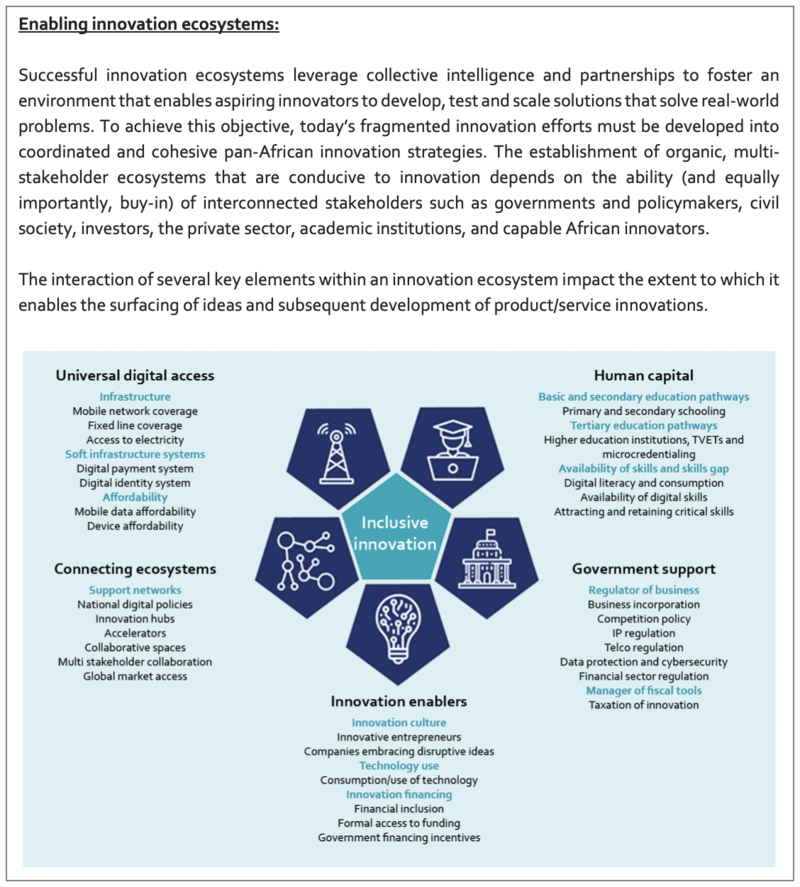Technological innovation is increasingly disrupting traditional sectors and encouraging inclusive economic growth that addresses development challenges within emerging markets. While the SADC region is not far behind in the use of technological innovation to foster growth, it is still trailing in the translation of tech-enabled innovation into meaningful social and economic impact. Product and service innovations have typically fallen short in addressing key challenges, such as employment creation, industry competitiveness, public service delivery, as well as economic empowerment. This contributes to a failure to stimulate inclusive growth that impacts people’s lives and decreases poverty.
African innovation refers to innovative technologies, start-ups, and programs developed by Africans for African needs and challenges – African Innovation Foundation
Supporting innovation is critical to the continued development of the SADC region but this demands a clear understanding of innovation ecosystems in the region and a strategic focus on solving key economic challenges. To take full advantage of the benefits of innovation, collaborative and enabling innovation ecosystems must be established which foster an environment for ideas to be generated, developed, tested, and scaled for impact. There is a clear need for SADC-focused innovation initiatives, employing strategic frameworks and methodologies that leverage the skills and capacities of the region, to enable innovations that advance financial and economic inclusion. It is, however, important to first understand the environment in which product innovations are to be fostered before such initiatives can be successfully implemented.
To address this need, FinMark Trust, in collaboration with insight2impact, embarked on an innovation ecosystem scoping exercise within the SADC region. This research is expected to lay the foundation on which to support the development of impactful innovation strategies, focused on leveraging the region’s strengths while alleviating key bottlenecks to innovation. In doing so, it will be plotting a coordinated effort for all relevant ecosystem stakeholders towards a common goal; an innovation landscape that is able to catalyse scalable solutions that positively impact SADC economies, its societies, and the livelihood of millions.

The scoping study provides an assessment of the ecosystem landscape in five countries within the SADC; South Africa, Tanzania, Zambia, Malawi, and Lesotho. These countries were selected because they provide a good cross-section of digital maturity, financial inclusion, and income per capita across the SADC region. Providing an overview of the contextual nuances across different ‘market profiles’ in the SADC region enables the extrapolation of findings to non-scoped countries falling along this spectrum. This approach allows for a clear understanding of the drivers of innovation ecosystem development and identifies key areas for improvement, while also ensuring the outcomes remain sensitive to contextual nuances within the region.
While each of the countries scoped in this study face nuanced and context-specific challenges, a number of key cross-cutting themes emerged:
- Infrastructure and affordability are critical barriers: While infrastructure development enables access to innovative products and services in urban areas, poorer populations are seldom able to access innovations owing to inadequate infrastructure development, especially in rural areas. Even where infrastructure is available, affordability is a challenge owing to data and device prices.
- Payments infrastructure as a core to innovation: Across four markets, excluding South Africa, most product innovations are built off of mobile money platforms. While this presents an entry point for innovation, it may also hinder innovation because of a reliance on incumbents’ systems and infrastructures.
- Quality of incubators: While there are several incubators and technology hubs in all markets, the quality and range of service differs. Most provide a shared working space with access to internet and networking opportunities, while only a few offer internships, mentorships, and targeted support services.
- Incumbents have an important role to play: Where digital literacy and familiarity is low, incumbents play an important role in facilitating market access. However, incumbents are often defensive in their attitudes towards start-ups and emerging innovations.
- Lack of relevant digital skills: Secondary and tertiary education pathways often fail to provide adequate digital skills relevant both to product adoption/use and those necessary for developing innovations. This results in a gap between the supply and demand of market-relevant skills and also limits the number of capable innovators/entrepreneurs.
- Limited access to funding: Innovators face difficulties in accessing risk-based financing. There are low levels of VC funding, angel investors, and crowd-funding platforms.
- Role of e-government: The role of government digital services in developing markets can play a large role in fostering a culture of innovation and adoption of digital technology. While South Africa scores fairly well in the digital provision of information and services, there is room to improve government use of technology across the other markets.
- National strategies for digital and innovation: Governments lack a coordinated national digital strategy that requires ministries to consult and support national initiatives.
While the SADC region continues to pose unique challenges, the balance between challenge and opportunity must be tilted in favour of the latter. Understanding the unique cultural, economic, and logistical difficulties facing innovation ecosystems in the SADC region is the crucial first step in overcoming key developmental challenges through innovation.
Read the full report here.
For more information on innovation or the work of FinMark Trust, please contact Dumisani Dube, Head of Innovation at dumisanid@finmark.org.za
